Chapter 04 Exploring Magnets Solutions
November 5, 2024Chapter 06 Materials Around Us Solutions
November 5, 2024Chapter 05 Measurement of Length and Motion Text Book Solutions
Let us enhance our learning
Q1: Some lengths are given in Column I of Table 5.5. Some units are given in Column II. Match the lengths with the units suitable for measuring those lengths.
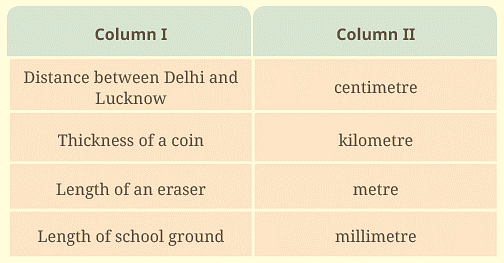 Table 5.5
Table 5.5
Ans:
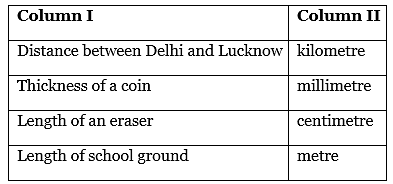
Q2: Read the following statements and mark True (T) or False (F) against each.
Ans:
(i) The motion of a car moving on a straight road is an example of linear motion. [T]
(ii) Any object which is changing its position with respect to a reference point with time is said to be in motion. [T]
(iii) 1 km = 100 cm [F]
Q3: Which of the following is not a standard unit of measuring length? (i) millimetre
(ii) centimetre
(iii) kilometre
(iv) handspan
Q4: Search for the different scales or measuring tapes at your home and school. Find out the smallest value that can be measured using each of these scales. Record your observations in a tabular form.
Ans:
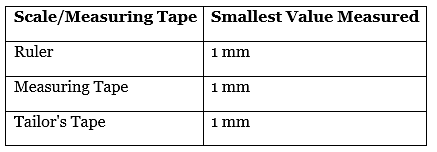
Q5: Suppose the distance between your school and home is 1.5 km. Express it in metres.
Ans: 1.5 km = 1.5 × 1000 = 1500 metres
Q6: Take a tumbler or a bottle. Measure the length of the curved part of the base of glass or bottle and record it.
Ans: Measure the curved part of the base by using a flexible measuring tape or a thread. Place the tape/thread around the base and note the measurement.
Q7: Measure the height of your friend and express it in (i) metres (ii) centimetres and (iii) millimetres.
Ans: If the height of your friend is 1.45 metres:
(i) Metres: 1.45 m
(ii) Centimetres: 145 cm
(iii) Millimetres: 1450 mm
Q8: You are given a coin. Estimate how many coins are required to be placed one after the other lengthwise, without leaving any gap between them, to cover the whole length of the chosen side of a notebook. Verify your estimate by measuring the same side of the notebook and the size of the coin using a 15-cm scale.
Ans:
- Estimate: If the side of the notebook is 30 cm and the coin diameter is 2 cm, you need approximately 15 coins.
- Verification: Measure the actual length of the side of the notebook and the diameter of one coin. Divide the length of the side of the notebook by the diameter of the coin to find the exact number of coins needed.
Q9: Give two examples each for linear, circular and oscillatory motion.
Ans:
- Linear Motion: A car moving on a straight road, a person walking in a straight line.
- Circular Motion: The motion of a fan blade, the motion of a merry-go-round.
- Oscillatory Motion: The swinging of a pendulum, the motion of a child on a swing.
Q10: Observe different objects around you. It is easier to express the lengths of some objects in mm, some in cm and some in m. Make a list of three objects in each category and enter them in the Table 5.6.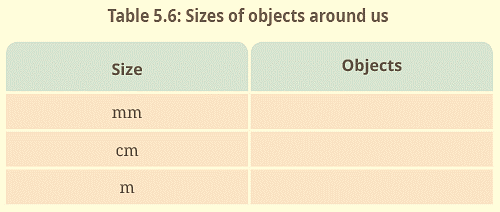
Ans:
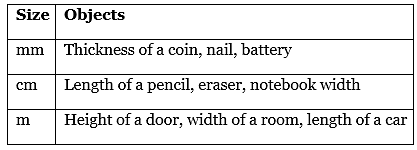
Q11: A rollercoaster track is made in the shape shown in Fig. 5.19. A ball starts from point A and escapes through point F. Identify the types of motion of the ball on the rollercoaster and corresponding portions of the track.
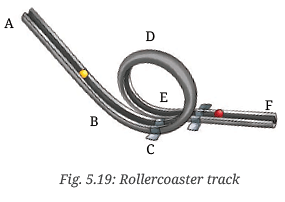 Ans:
Ans:
From A to B: Linear Motion
From B to C: Circular Motion
From C to D: Linear Motion
From D to E: Circular Motion
From E to F: Linear Motion
Learning further
Q12: Can you find the thickness of a single page of your notebook or textbook using a scale? Think of a way and write it. Carry out the activity and report your result.
Ans:
- Method: Measure the thickness of 100 pages together using a scale, then divide the measurement by 100 to find the thickness of a single page.
- Example: If the thickness of 100 pages is 1 cm, the thickness of one page is 1 mm.
Q13: Collect fallen leaves from the same tree. Identify the name of the tree whose leaves you have taken. Measure the length and breadth of all these leaves using a 15-cm scale, as shown in Fig. 5.20. Record your observations in the Table 5.7.

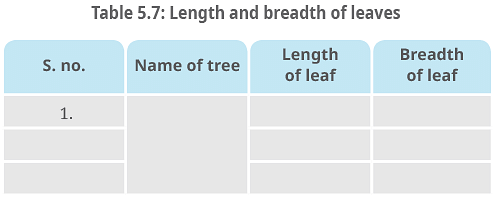
Ans:

Q14: Discuss why the leaves of the same tree vary in length and breadth.
Ans: Leaves of the same tree vary in length and breadth due to factors such as age, position on the tree, availability of sunlight, nutrients, and genetic variations.
Q15: Tasneem wants to make a metre scale by herself. She considers the following materials for it—plywood, paper, cloth, stretchable rubber and steel. Which of these should she not use and why?
Ans: She should not use stretchable rubber because it can stretch and give inaccurate measurements.
Q16: Think, design and develop a card game on conversion of units of length to play with your friends.
Ans: Create cards with different units of length (e.g., mm, cm, m, km). Players draw cards and must convert the units correctly to win points. The game can include challenges and multipliers for converting more complex units.
Q17: Discuss with elders in your community what units were used for measurement of length in the olden days. Also, using the internet, try to find out about the length scales found in excavations of archaeological sites in India.
Ans: In olden days, units such as angula (finger width), dhanusa (bow length), and yojana (distance) were used. Archaeological sites in India have revealed measuring scales with markings that were used in the Harappan civilization.
Q18: Create a maze using lines of 1 cm, 2 cm and their combination. Part of it has been made for you in Fig. 5.21. Now use your imagination and expand it to a size as big as you want.
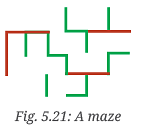
Ans: Expand the maze by drawing additional lines of 1 cm and 2 cm lengths, ensuring there is a clear path from the start to the end.
Q19: How tall am I? Stand along a wall and with the help of an adult, mark your height (Fig. 5.22). Repeat it every three months to maintain a height record for yourself and your siblings.
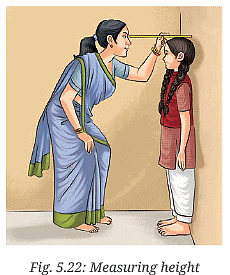
Ans: Stand against a wall and mark your height using a pencil. Measure the height from the floor to the mark using a tape measure or a scale. Record the measurements every three months.
Q20: Let us design a fun method for measuring the distance between two places by using a bicycle. Attach a flexible metal strip to the spoke of the front wheel in such a manner that it hits the frame of the bicycle holding the wheel, every time it crosses it and produces a sound (Fig. 5.23).
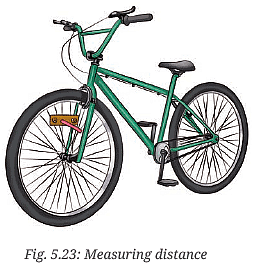
Now ride the bicycle slowly and count the number of times in which sound occurred. The number will give you the number of turns of your wheel made. Now measure the length of the outer boundary of the wheel using a string as done in Fig. 5.8. Multiply this length by the number of turns of the wheel. This is the distance you travelled. Such methods are actually used to measure the distance for road running races. Try to find out about a ‘Jones Counter’ which is attached to a bicycle wheel and is used for measuring distances.
Ans:
Ride the bicycle slowly and count the number of times the sound occurs, which represents the number of wheel rotations.
Measure the circumference of the wheel using a string and a scale.
Multiply the number of wheel rotations by the circumference to find the total distance travelled.

